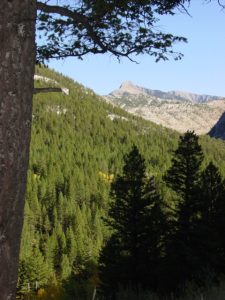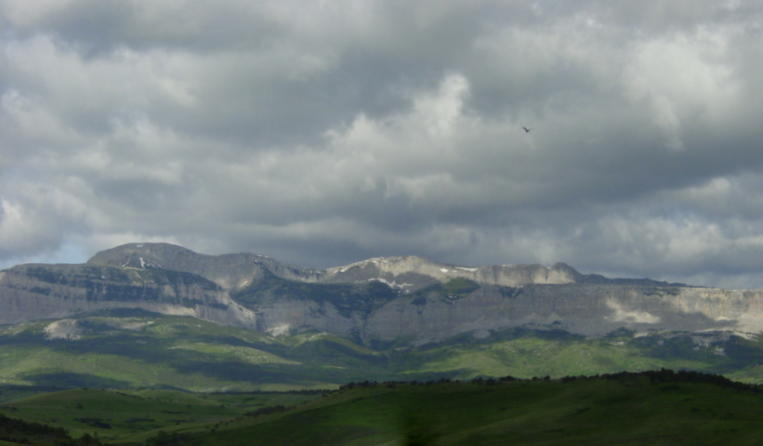Phytomigration: Moving Forests
“Simplify, simplify.” Henry David Thoreau

West Pioneers, MT
Something terrible is happening and only you can save the day.
The forests of western North America are dying. Bugs, drought and disease are killing trees by the hundreds of millions. This is severely impacting the dependent understory plants and wildlife. The pace of this carnage increases every year. Although interruption of the natural fire cycle and mismanagement play a role, by far the worst culprit is warming winter temperatures. It is simply not getting cold enough, long enough, to kill the bugs. Changing precipitation patterns and generally lower snowpack contribute to the problem. That’s the bad news. History tells us what happens when forests disappear. When I think about this I can’t help but worry about the impact on our grandchildren. Then I get angry.
The oceans are acidifying and losing oxygen. The tropical rainforests are shrinking every day. The signs of mass extinction, intense drought and worsening natural disasters are everywhere. But these coniferous forests in the Northwest are where we dwell. We are sylvani – forest people. It is here I see the crisis out my back door and it is here that I can have the most positive impact.
I did not use the term climate change in the above paragraphs because it makes some people itch and lose cognitive ability. Call it what you want. The trees are still dying.
Climate naturally changes, of course. But this shift is occurring so rapidly that the normal rate of tree migration will simply not keep up. A recent University of Idaho study projects that the habitat for trees native to this area will no longer be present in a few decades. The odds are larch and lodgepole pine (two major species in this area) will no longer have suitable habitat here by 2030. In one human lifetime the suitable habitat for all the native species will be somewhere else.
This trend is firmly in place and accelerating. Can anything be done to stop this pyroclastic flow of events? Perhaps a feedback loop not yet anticipated by climate scientists will develop to slow or arrest the pace of warming. As one example, some mention increasing cloud cover due to more ocean evaporation at higher latitudes might slow some of the effects of lost sea ice. At this moment that possibility falls into the “hope and prayer” category. Perhaps humanity will stare into the abyss (instead of a Kardashian’s better end) and begin a massive collective effort to save the natural world (and ourselves) from this ultimate disaster. Okay… Enough fantasy. We are learning that climate agreements, like peace treaties and constitutions, can be weakened, ignored and subverted by powerful people with an interest in maintaining the status quo – or worse. You know who they are. You know what they want.
So what can you do? Well, you can drink homemade brandy and bitch about it. While some of that goes on here, our real answer at TerraFlora is the same as it is for many problems grand and small: Pick up a shovel. Plant trees. Plant billions of trees, at least one for every human on the planet. You better start now. It’s a big job. Ancient forests need to be replanted and restored. Deserts need to be reclaimed. Millions of tons of biochar need to be buried in both forest and agricultural soils. Wherever you are, it’s time to get busy.
But what can we do about the dying forests of western North America? As I look out the window I see hundreds of trees stretching up the hill. All of the lodgepole pine are dead or dying. They all have to go. Almost half the larch are dying or generally unhealthy. Wildfire is a risk and the size and intensity of fires grow every year. I am always amazed when large scale tree planting for fire restoration or logging rehabilitation involves planting the same tree species that just succumbed to bugs or disease and burned.
We must enhance and accelerate phyto-migration in our region. What trees and understory plants will grow here in forty years? A hundred years? Will this area support a ponderosa pine park, an oak savannah? Will all coniferous trees succumb to the bugs, or are there species that now grow in the states to our south that will survive and thrive here in the decades ahead?
Many of us at higher elevation or latitudes who practice permaculture on some level also engage in ex-situ conservation. That is, we stretch our hardiness zones with trees, shrubs and perennials that naturally grow in warmer climes. Establishing micro-climates for extending growing seasons is a tried and true permaculture technique. By planting against a wall, among dark stones, adjacent to a water feature, and heavy winter mulch we can grow plants that otherwise would not mature and yield in our location.
This technique needs to be expanded on a large landscape scale. This absolutely must be done. It’s not an option. We can’t wait for the government, state or federal, to figure this out. We can’t rely on the major corporate timber producers to take the lead because they have to think in terms of quarterly profit and loss statements. We, on private land or as part of community projects, must do this work ourselves. We need to establish pioneer plantings of valuable trees and understory plants now.
As you know, several degrees of warming are already baked into the global cake. By planting billions of trees and managing for healthy forests we can take the peak off the spike and level out the amount of carbon in the atmosphere. This may allow our grandchildren to inherit a warmer but livable world and a chance to lead lives with the potential for dignity and joy. What is more important than that? Do not be put off by the size of the challenge or by the audaciousness of the goal. Saving the world ain’t easy, but you can do this. We can do this.
More on our plans, techniques, and results here at TerraFlora will be covered in the next posts. I hope this work will be of interest to you.
Until we meet again – pick up a shovel.
Written by Marc Flora of TerraFlora Permaculture

Hi Greg, thanks for connecting! Love your concept and Ashland is a wonderful place to launch it. I have a number of family and friend connections there and lived there for a year. We’re very impressed by all your connections to literal eco-powerhouses around the world you highlight on your website. I’ve been on the Advisory Board of Algae AquaCulture Technologies since they started, providing the biochar input which is the basis for their soil amendments. Good people and exceptional outcomes.
We’re located about 80 miles north of Spokane so don’t get there too often. Is that where you are located? Our emails are gloria@t__.net and marc@t__.net. That’s the best way to reach us.
I would like to dialog on collaboration, on local, national and global scales to actively tackle issues brought up by your heroic efforts to ‘turn this ship around’ in a new direction. I will be moving to Ashland, OR, to establish my Earth Stewards Trust & White Tiger Farm, to showcase off grid tech to provide abundant clean energy, food and water production for a sustainable future for all people, and
nations, while using Food Forests/Permaculture/Edible Landscaping to save threatened plant and animal species, and the habitats they call home. http://whitetiger511.tripod.com is my site online, I hope that Gloria and Mark Flora pay it a visit, and get in touch with me in Spokane, WA, at their earliest convenience.
Make a more new posts please 🙂
___
Sanny
Thanks for the reminder and motivation to post some of our recent articles, Sanny. Wonderful to know you’re visiting our site!
I have enjoyed reading your article in the current issue of Permaculture Design.
I suspect that a typo exists on page 32, regarding the shade tolerant species that are susceptible to fire effects?
Here in the Midwest, the oaks and hickory tolerate fire, versus shade tolerant maple and beech.
Thanks Jim! I think we’re agreeing but perhaps my wording was unclear? Shade tolerant species are more susceptible to wildfire than sun-lovers, just like your example of local maple and beech. As density of forests increase, there’s more shade, thus more habitat for shade-lovers. But these trees are not physically suited to resist wildfire, the way species that prefer full-sun are. Thanks for confirming the concept with an example from another region! Gloria